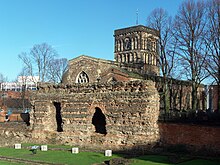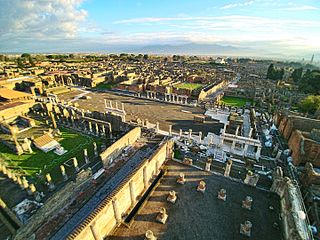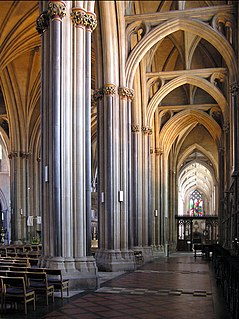
The Cathedral and Metropolitical Church of Saint Peter in York, commonly known as York Minster, is the cathedral of York, England, and is one of the largest of its kind in Northern Europe. The minster is the seat of the Archbishop of York, the third-highest office of the Church of England, and is the mother church for the Diocese of York and the Province of York. It is run by a dean and chapter, under the Dean of York. The title "minster" is attributed to churches established in the Anglo-Saxon period as missionary teaching churches, and serves now as an honorific title. Services in the minster are sometimes regarded as on the High Church or Anglo-Catholic end of the Anglican continuum.
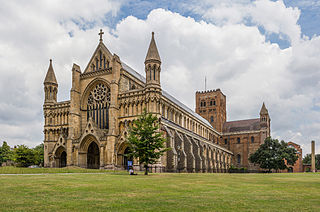
St Albans Cathedral, sometimes called the Cathedral and Abbey Church of St Alban, and referred to locally as "the Abbey", is a Church of England cathedral in St Albans, England. Much of its architecture dates from Norman times. It ceased to be an abbey in the 16th century and became a cathedral in 1877. Although legally a cathedral church, it differs in certain particulars from most other cathedrals in England: it is also used as a parish church, of which the dean is rector with the same powers, responsibilities and duties as that of any other parish. At 85 metres long, it has the longest nave of any cathedral in England.

Cologne Cathedral is a Catholic cathedral in Cologne, North Rhine-Westphalia, Germany. It is the seat of the Archbishop of Cologne and of the administration of the Archdiocese of Cologne. It is a renowned monument of German Catholicism and Gothic architecture and was declared a World Heritage Site in 1996. It is Germany's most visited landmark, attracting an average of 20,000 people a day, and currently the tallest twin-spired church at 157 m (515 ft) tall, second in Europe after Ulm Minster and third in the world.
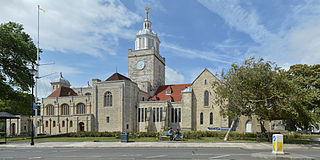
The Cathedral Church of St Thomas of Canterbury, commonly known as Portsmouth Cathedral, is an English cathedral church. It is the cathedral of the Church of England Diocese of Portsmouth and is located in the centre of Old Portsmouth. It is the seat of the Bishop of Portsmouth.

The Church of Saints Peter and Paul is a Roman Catholic church in Singapore. It is located at Queen Street within the Central Area known as the Bras Basah Bugis precinct of Singapore's arts district.

St Michael's Church, St Albans is a Church of England parish church in St Albans, Hertfordshire, England. Much of the building is late 10th or early 11th century, making it the most significant surviving Anglo-Saxon building in the county. It is located near the centre of Roman Verulamium to the west of the modern city.

St Luke's Church is in the village of Holmes Chapel, Cheshire, England on the A50 road at its junction with the A535 road. The church is recorded in the National Heritage List for England as a designated Grade I listed building. It is an active Anglican parish church in the diocese of Chester, the archdeaconry of Macclesfield and the deanery of Congleton.

St Helen Witton Church, Northwich, is in the centre of the town of Northwich, Cheshire, England. It is recorded in the National Heritage List for England as a designated Grade I listed building. The church is now known as "St Helen's, Witton" or "Northwich Parish Church". It is an active Anglican parish church in the diocese of Chester, the archdeaconry of Chester and the deanery of Middlewich. Alec Clifton-Taylor includes it in his list of 'best' English parish churches.
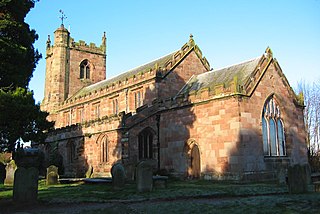
St Margaret's Church overlooks the village green of Wrenbury, Cheshire, England. The church is recorded in the National Heritage List for England as a designated Grade II* listed building. It is an active Anglican parish church in the diocese of Chester, the archdeaconry of Macclesfield and the deanery of Nantwich. Its benefice is combined with those of St Michael's, Baddiley and St Mary's and St Michael's, Burleydam.

St Mary's Church is in the village of Lymm, Cheshire, England, standing on a bank overlooking Lymm Dam. The church is recorded in the National Heritage List for England as a designated Grade II listed building. It is an active Anglican parish church in the diocese of Chester, the archdeaconry of Chester and the deanery of Great Budworth.

St Bede's Church is in Appleton Village, Widnes, Cheshire, England. It is an active Roman Catholic parish church in the Archdiocese of Liverpool. The church is recorded in the National Heritage List for England as a designated Grade II listed building.

St Margaret's Church is in Main Street, Hornby, Lancashire, England. The church is recorded in the National Heritage List for England as a designated Grade I listed building. It is an active Anglican parish church in the diocese of Blackburn, the archdeaconry of Lancaster and the deanery of Tunstall. Its benefice is combined with those of St Michael, Whittington, St John, Arkholme, and St John, Gressingham.

Lancaster Priory, formally the Priory Church of St Mary, is the Church of England parish church of the city of Lancaster, Lancashire, England. It is located near Lancaster Castle and since 1953 has been designated a Grade I listed building. It is in the deanery of Lancaster, the archdeaconry of Lancaster and the Diocese of Blackburn. Its benefice is combined with that of St John and St Anne.

St. Mary's Church is a Grade I listed Anglican church in Chesham, Buckinghamshire, and is part of the Diocese of Oxford. Built on the site of a Bronze Age stone circle of puddingstones, parts of the church building date to the 12th century. Remodelled in the 15th and 17th centuries, the church is architecturally a mixture of English Gothic styles. Weakened by additions to the church tower and undermined by burials in and around the church, by the 19th century the building was structurally unsound. The church was remodelled and strengthened in the 1860s by George Gilbert Scott and again in the 20th century by Robert Potter.

St John's Minster, formerly the Church of St John the Evangelist, is in Church Street, in the centre of Preston, Lancashire, England. From its origin it has been the parish church of Preston. It is an active Anglican church in the deanery of Preston, the archdeaconry of Lancaster and the diocese of Blackburn. Its benefice is united with that of St George, Preston. St John's is recorded in the National Heritage List for England as a designated Grade II* listed building.

St John the Baptist's Church is in Church Lane, Broughton, Lancashire, England. It is an active Anglican parish church in the deanery of Preston, the archdeaconry of Lancaster, and the diocese of Blackburn. Its benefice is united with those of St Martin, Fulwood, and St Peter, Fulwood. The church is recorded in the National Heritage List for England as a designated Grade II* listed building.
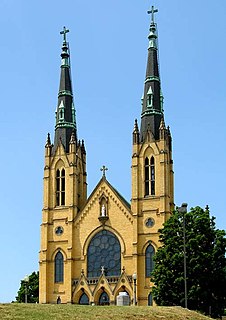
St. Andrew's Catholic Church is a historic Roman Catholic church and rectory in Roanoke, Virginia, United States. It was built in 1900-1902, and is a buff brick church on a stone foundation in the High Victorian Gothic style. It has a cruciform plan and features two tall Gothic towers which flank the main entrance and are square in plan. On each tower are two small lancet windows, two large pointed-arch stained-glass tracery windows, and sets of double pointed-arch openings at the belfry. Also on the property is a rectory built in 1887. The church replaced an earlier small brick church built in 1883.

The Church of St. John the Evangelist is a Gothic Revival architecture style Roman Catholic church in the United States and a prominent landmark of the City of Orange Township, Essex County, New Jersey. It is a parish church, located at 94 Ridge Street, Orange, New Jersey.
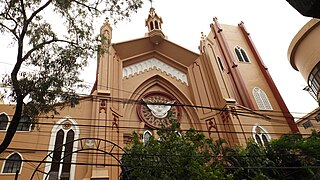
Espiritu Santo Parish, now known as the Archdiocesan Shrine and Parish of Espiritu Santo, is a Roman Catholic parish belonging to the Archdiocese of Manila that is located along Tayuman Street corner Rizal Avenue, Santa Cruz, Manila, Philippines. It was declared an Archdiocesan Shrine by Manila Archbishop Luis Antonio G. Cardinal Tagle on June 8, 2014, the Solemnity of the Pentecost. Rev. Fr. Wilmer R. Rosario, JCD is the present parish priest and rector of the church, succeeding Rev. Msgr. Albert G. Salonga, PC, who has been its parish priest from 1998 to 2015.

Roberts Park Methodist Episcopal Church, whose present-day name is Roberts Park United Methodist Church, was dedicated on August 27, 1876, making it the oldest church remaining in downtown Indianapolis. Diedrich A. Bohlen, a German-born architect who immigrated to Indianapolis in the 1850s, designed this early example of Romanesque Revival architecture. The church is considered one of Bohlen's major works. Constructed of Indiana limestone at Delaware and Vermont Streets, it has a rectangular plan and includes a bell tower on the southwest corner. The church is known for its interior woodwork, especially a pair of black-walnut staircases leading to galleries (balconies) surrounding the interior of three sides of its large sanctuary. The church was added to the National Register of Historic Places on August 19, 1982. It is home to one of several Homeless Jesus statues around the world, this one located behind the church on Alabama Street.
